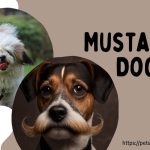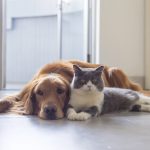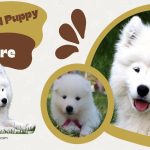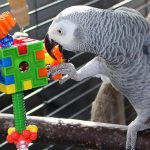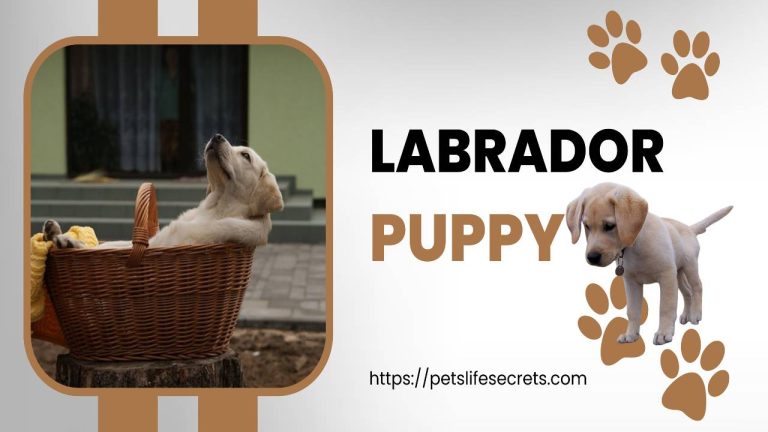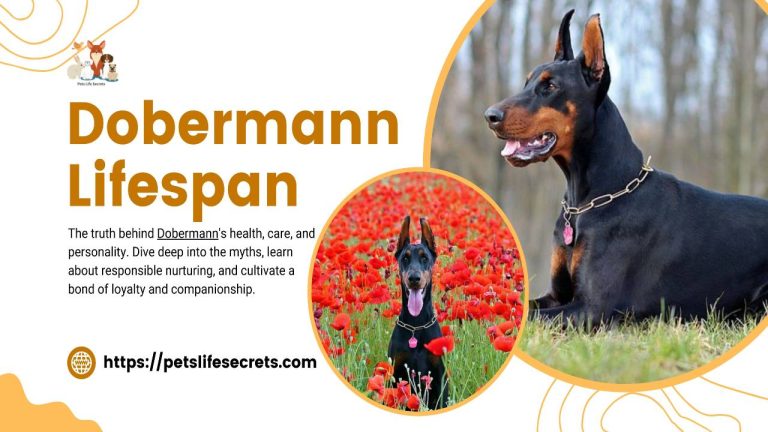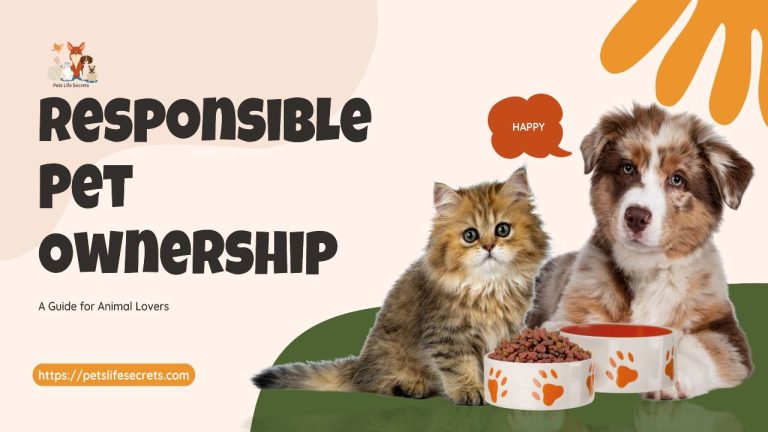Discover the incredible strength and unrivaled tracking abilities of Bloodhound puppies, the world’s strongest Hound dogs. Learn how to adopt, train, and care for these remarkable companions, and find answers to frequently asked questions about their exercise needs, training techniques, and more.
Table of Contents
Introduction:
- Introduction to Bloodhound puppies
- Importance of fulfilling their needs and responsibilities
Bloodhounds belong to one of the oldest breeds in history, which has been recognized for its great tracking skills through its great sense of smell, being acknowledged as one of the best smelling dogs in the world. It’s a large hound dog, which has peculiar physical characteristics such as its large drooping ears, wrinkled face, and much more. It is a breed that shows loyalty, love and forms a great bond with their owners, equally if you are looking to have a Bloodhound puppy you should make sure you can fulfill all their needs and responsibilities. If you are interested in learning more about the Bloodhound, read on.
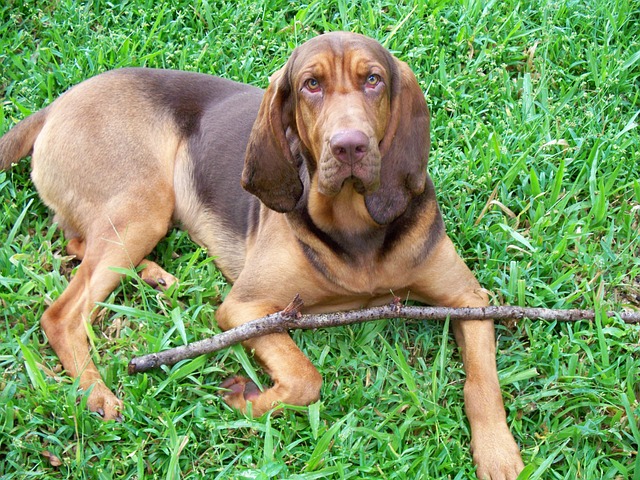
History of Bloodhound puppies
- Ancestors of Bloodhounds
- Origins in Western Europe
- Introduction to England
- Development of the modern Bloodhound
- Recognition by The American Kennel Club
The ancestors of the current breed of Bloodhounds have been recognized in history over a thousand years ago, some believe that they had a presence in the ancient Mediterranean because, scholarly anecdotes counted the presence of a dog that had a great sense of smell and were suitable for hunting, also they were large and black. Officially it is recognized that the current Bloodhounds come from Western Europe, specifically in the Monastery of Andain, located in the Ardennes region of Belgium,
where a monk named Hubert was dedicated to the breeding of hunting and hound dogs to track big cats, wolves, deer, or to follow the trail of wounded prey, also used to make hunting journeys. Among the dogs he bred, there was the predecessor of the Bloodhound, called “Segusius”; after his death, this monk was canonized and granted the title of Saint Hubert, patron of hunting, and founder of the Order of Monks of Saint Hubert.
For many years this dog was unknown in the world, as they were kept isolated in the region and were also given the name of St. Hubert Hound. Later this dog was introduced to England when King William “The Conqueror” brought with him specimens of this breed for its exceptional qualities as a hound dog during the XI century.
The descendants of these were called Bloodhound, it was a familiar word used in the English language, making reference that this dog belonged to the status of an aristocratic breed that only the nobility could have, in other words, it was a way to refer to the purity of their blood. As time goes by, it is believed that the modern Bloodhound is the result of selective crosses between the descendants of the first specimens imported from Belgium with some individuals of the Bullmastiff breed, even though it is not the same identical dog of that time.
As time went by, this breed was recognized as a tracking dog, its great sense of smell allowed it to stand out in every era, where it was used for diverse activities and reached different parts of the world such as the United States. The bloodhound was recognized by The American Kennel Club (AKC) in 1885 together with 14 other breeds shortly after it was founded to preserve, care for and recognize the purebreds of each dog breed at that time.
The Bloodhounds were initially used to chase deer and other games, but over time they came into more professional use, where currently they are used as police dogs to assist the search and rescue efforts of humans whether, by the scent from a criminal, a lost child or a confused senior, their skills have such high value that they are well recognized in evidence trials admitted in court. Also, they are a perfect pet to have at home.
Features of Bloodhound puppies:
- Description of Bloodhound’s physical characteristics
- Size and weight variations
- Notable features: droopy ears, wrinkled face, and strong body
- Coat colors and variations
The Bloodhound belongs to the large dog group and is the strongest dog among the hound type dogs in the world, according to the official Federation Cynologique Internationale (FCI) standard. His body is longer than wide with a rectangular shape, with a toned and muscular appearance, with great strength and striking appearance.
They have an approximate life expectancy of about 10 to 12 years. The size of their large body can vary according to sex, the male can weigh between 90 and 130 lbs with an average height of 25 and 27 inches but can also reach about 32 inches. The females can weigh between 80 and 100 lb and have an average height of 23 to 25 inches although some can reach 28 inches.
His head is in proportion to his body, is a large, wide, and square profile, has a great abundance of loose skin with folds and wrinkles ranging from the face to the neck, has long and large ears that fall on the sides of the face, with good separation between them and the touch is velvety. His eyes are diamond-shaped due to his droopy eyelids that end up giving him that shape, making him look over time with a sad face and even showing the conjunctive part of them, his eyes can go from a deep hazelnut tone to a yellow color.
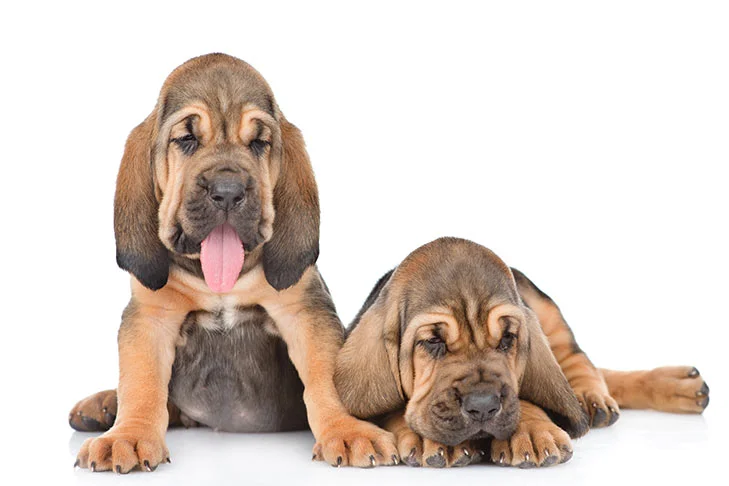
Its muzzle is long, wide, and protruding, it has to be as long as the dog’s skull, its nose has its nostrils very wide and open that allows them to have one of the best smells among dogs and its nose color can be black or brown. Its extremities are straight, thick, and strong, with a very good musculature that allows it to have agility and ability to move. Its tail is long with a curve that leans upward.
His coat is short, hard, and smooth, its texture may vary depending on the body part, can be softer and velvety in the head and ear area, while it may be a little more abundant and rough on the tail. According to the AKC is accepted in the Bloodhound 3 variations of colors in its coat are black and tan, liver and tan, and red. Sometimes some shades may be more predominant than others on its body , also a minimum amount of white shades may be accepted but only in the area of the chest, legs, and tail.
Personality of Bloodhound puppies:
- Bloodhound’s temperament and behavior
- Shy, patient, calm, and loving nature
- Importance of early education and socialization
- Interaction with children and other pets
Although the Bloodhound temperament may seem like an intimidating dog because of its large size, it is actually quite the opposite, they are known to be shy natures, patient, calm, and loving. Once you bring the puppy, you have to take care of their education and positive socialization, although by nature they are calm.
It is good to teach them from a young age starting from the third month, to get used with everything and become more obedient, since they tend to be somewhat independent in personality they can begin to make their own decisions.
Never take a violent attitude at educating them since in this way they can develop an aggressive attitude, you should focus on putting limits on them, inside and outside the house stimulating and rewarding them in a positive way. With good socialization, these dogs usually get along very well with other dogs and other pets, also due to their patience they get along very well with children, but if they are very small it is always recommended to watch them because due to their size and strength they can harm without any intention.
Althought, you should teach your children if it is the case, how to treat and respect your pet, they are also friendly dogs and accept and receive visits from people known or strangers, but if he feels that his family is in danger do not doubt that he will stay calm, this breed is deeply loyal to his family.
Normally bloodhound puppies tend to be more active and playful, but once they are adult dogs they like to spend specific time to stay active and spend time indoors quietly. Although it doesn’t seem like it, this dog tends to be very dependent on its owners, so loneliness is not something they usually tolerate.
If you leave your dog alone too much, it can start to be destructive or suffer from separation anxiety, even develop depression, so this is an important fact to consider before getting a bloodhound pup, but if you have a family and you know it will always be accompanied, there is nothing to fear. You can also establish schedules to play and exercise with him.
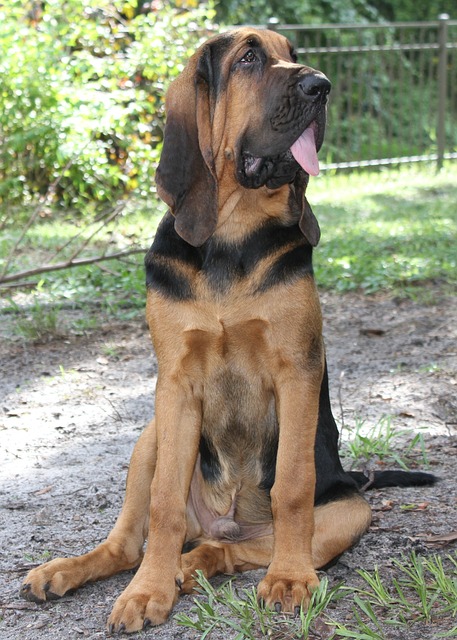
Click Here For: How to true care for pets : #1 Tips Forever
Another important fact to take into consideration is that these dogs due to their size cannot live in small spaces, so it is not recommended that they live in apartments, the best thing is that they have access to large spaces where they can move around better and have access to yards or gardens but only if it is a fenced yard because as they have a great sense of smell, sometimes they get carried away by an interesting scent and seek to find them anyway,
apart from the fact that they are not aware of the risks and dangers of their surroundings because they are focused with their head down, nose touching almost the ground and their ears possibly covering their sight. When they are outside, they can be very communicative and they are dogs that can express well their squeals, howls, and whines, but when they are at home they are usually silent. Also due to the loose folds of their skin, they tend to drool a lot, so if you are a clean lover take note of this.
Care of Bloodhound puppies:
- General care guidelines for Bloodhounds
- Grooming requirements: brushing, bathing, and cleaning skin folds
- Dental, eye, and ear care
- Exercise needs and recommendations
- Mental stimulation and training
- Considerations for living arrangements and space requirements
For the care of the Bloodhound breed is a very simple work as his coat, requires only a weekly brushing to remove the dead hair and prevent your house to be filled with hair everywhere, also in this way stimulate the natural skin oils to maintain a healthy coat.
You can bathe him regularly, if you want, once a month is more than good because they tend to develop a doggy smell, try not to bathe him too often either because it is not healthy for his skin, you can also bathe him only when he is very dirty, use only special shampoos for dogs that do not contain chemicals that affect their health.
Due to the amount of skin that has the Bloodhound dog you should always check their skin folds and wrinkles to see if it needs cleaning. I recommend that you clean them with a wet wipe and then dry it so it doesn’t get humid because bad hygiene can develop fungus and other problems.
You should always check and clean their teeth to maintain good oral hygiene. Bloodhounds are also prone to eye and ear infections, so you should always keep or check their eyes and ears clean. Also, make sure that the Bloodhound’s nails should be trimmed regularly using a dog nail clipper.
Even though the Bloodhound is a dog that requires daily physical exercise is not a hyperactive dog, you must make sure he exercises daily, teach him to use a leash from a puppy, so that as an adult dog he can enjoy long walks to spend his energy and take advantage of the opportunity to use his sense of smell in new roads since they are very curious, you can dedicate him about 2 hours a day of exercise or divide the time between 2 or 3 exits with a proportional schedule that works.
Prevent a lazy dog from lying down all day, doing nothing, since they are prone to develop obesity, stress, or depression, so it will not be good for their health. Like the Neopolitan Mastiff, you must be very careful at the moment of making exercise, you must be careful in avoiding that he makes jumps, or climb stairs as they are a puppy, so they can have a good development in the bones, don’t have any problems in the future, and reach maturity in a good physical state.
Just as it is important to maintain physical health, it is also good to maintain good mental health, interact with your Bloodhound from puppy daily and give him his dose of love is very important for them, you can also make intelligent games that allow him to stimulate and develop his mind more, taking advantage that he has a good smell you can make games of burying different things in different places and make your pet go look for it.
Always look for ways to stimulate and train him correctly, this way they can develop a good relationship and be sure that your dog will thank you with his loyalty and love.
Bloodhound puppies Food:
- Importance of high-quality nutrition for Bloodhounds
- Nutritional needs in different life stages: puppies, adults, and seniors
- Feeding recommendations and portion control
- Safe human foods for dogs
- Water intake and resting after meals
The feeding of the Bloodhound breed is mainly based on providing high-quality food, which complies with ingredients that are beneficial to their health, moreover, provide good nutrition for their growth, also in this way you can avoid future diseases. Wherever you go to get dog food you should make sure you check all the ingredients it has, and if they are the right ones for its condition. You should always allow them access to water that is clean and fresh. Plus, before and after every meal allows them to rest for at least 1 hour.
Depending on the age of this dog breed you have to focus on what nutritional aspects are right for their development. These are divided into 3 stages:
Puppies: once your new pet is ready to be weaned, you can choose a high-quality puppy food and make sure it contains vitamins, iron, calcium, and protein. This will allow your puppy to grow in good health and without any bone or muscle problems. Pups improve with a routine, so establish and set guidelines for a moderate schedule for eating, so you can maintain it while continuing to grow, encouraging better breeding.
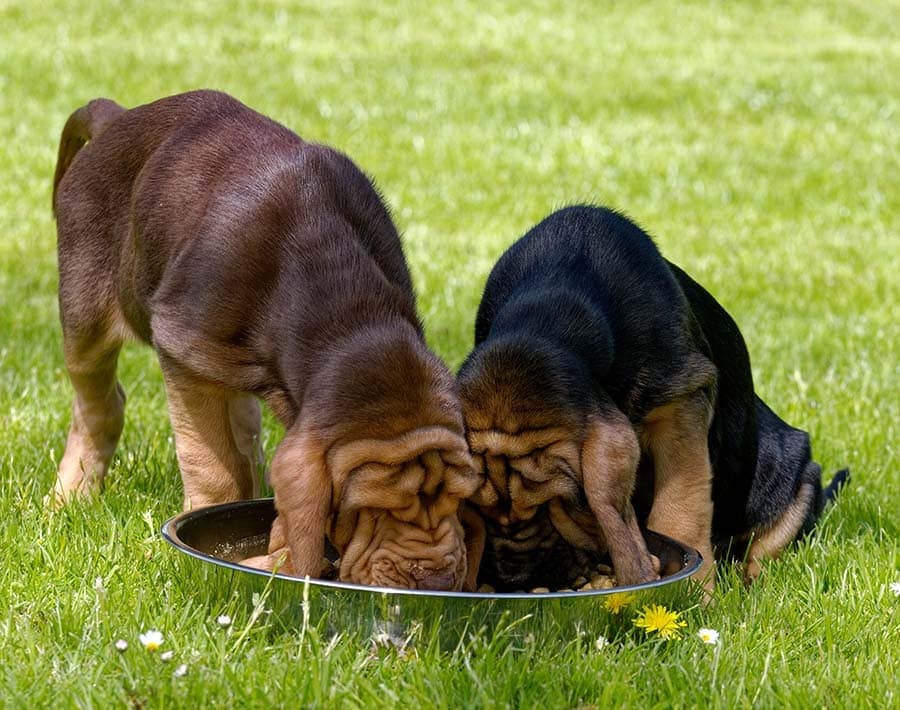
Adult:as they are large dogs they also need large doses of food. I recommend that you ask your vet what is the best amount you can give them, as it can vary according to their weight. If they exceed the amount of food and water they need, and later exercise, they can develop gastric torsions, with the consequence of great risks to their health.
They must contain a high degree of protein and you can choose their feeds depending on their lifestyle, whether they are dogs that exercise constantly, or are normal life dogs or even feeds that help them lose weight if they are overweight.
Senior: after the age of 7 you should start focusing on what type of nutrition is most suitable for your dog. Unlike other ages, the amount of protein can be reduced in case they are in delicate health, your vet will recommend which diet is most beneficial for them.
You can also choose to feed them with Human foods that are safe for your pet, you can ask your veterinarian what type of food is best or not to feed them. You can give your dog treats and more when you are training him, since this way he will feel rewarded but you must still control the amount you give him since they contain high levels of calories and can cause obesity.
Click Here For: How to take care of Beagle Puppies #1
Health of Bloodhound puppies:
- Genetic diseases and common health conditions in Bloodhounds
- Hip dysplasia and joint problems
- Signs of potential health issues
- Regular vet check-ups and prompt medical attention
Like many dog breeds, the Bloodhound is equally prone to developing genetic diseases or conditions that affect its health. One of the main ones that are better known in dog breeds with high weight and similar proportions like a Rottweiler, tend to suffer from hip dysplasia being one of the most common, it is an Inherited disease that makes the hip bone doesn’t fit with the femur, causing wear and joint pain. Then, if you see your dog limping, you should go to the vet as soon as you can as with any other changes in his behavior.
Another condition that is very similar to this situation is elbow dysplasia but limping by the front legs, that with early diagnosis it can be treatable and even prevented. Also, other diseases that can occur to this dog breed are hypothyroidism, which appears when there is a problem with the thyroid hormone, you can notice the symptoms when it begins to present obesity, is tired for no reason, loses a lot of hair, and may present infertility.
Because of the wrinkles or loose skin around his eyes the Bloodhound it’s also prone to suffer ectropion and entropion, this is a disease that affects the eyelid exposing the eye, and can suffer infections, irritating or injuring the eyeball, both can be corrected by surgery if it’s necessary.
Additionally, they can develop a skin infection called fold dermatitis that is caused by moisture trapped in the folds of the skin. The first signs of this dermatitis are redness in the skin, the appearance of sores, and bad smells that can affect areas like the tail, lips, face, or any other wrinkled area. It can be treated with topical ointments or antibiotics under the recommendation of a veterinarian. In case of a serious case, it can be removed by surgery.
Bloodhound dogs are prone to suffer reactive seizures which is an inherited condition that they can suffer, if your pet starts suffering from seizures usually appear starting from the sixth month and three years of age. This can happen when the brain responds to a metabolic problem like low blood sugar, organ failure, or a toxin.
If you see your dog having seizures, avoid that he hurts himself, also don’t try to control his mouth or grab his tongue since it could be a danger for you and it won’t be of much help for him either, from the first moment you see this happen you should take him immediately to the vet to make all the pertinent tests to get the cause if it is treated early, he can be given medicines for a lifetime to control it and you should take him to constant blood checks to avoid any negative effect.
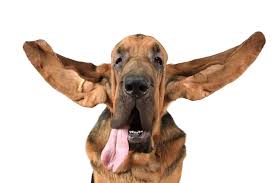
Click Here For: Jack Russell Terrier: A Comprehensive Guide to History, Features, Care, and Health
One of the most serious diseases that dogs like the Bloodhound have because of their long and deep chest is called Gastric dilatation-volvulus or usually called Bloat, this happens because your pet eats fast and in large quantities, drinks too much water, and then exercises, as a consequence it causes the stomach to fill with air or gas causing it to squirm, the dog is unable to burp or vomit to release those pressures in the stomach, therefore, preventing the normal backflow of blood to the heart, so the blood pressure drops and ends up going into shock.
If you find your dog is salivating excessively, trying to vomit but unable to, and you see his abdomen distended, you should take him to a vet immediately, otherwise, he could die.
As this breed is prone to many diseases, many pet owners decide to buy Pet health insurance, which helps them with future expenses and avoids large payments on possible surgeries. You can investigate which insurance is the most useful for you and covers all your needs.
The best way to prevent all these diseases from developing is with a constant checkup from puppies, also at the time you get to observe any abnormal symptom, you should take it immediately to check with the doctor. You should always be up to date with his vaccination schedule and do his continuous deworming.
Bloodhound puppies Breeding:
- Benefits of owning a Bloodhound puppy
Bloodhound puppies, If you consider that this is the right breed for you and you want to get a bloodhound puppy, you can do it through a reputable breeder within the AKC marketplace, since it is the only exclusive site that has registered 100% of litters and the breeders who have really cared and dedicated to raising puppies following the rules and regulations established by the AKC.
In this way, you can be sure that your puppy is in good health through all the certificates and tests performed, that he was raised in good conditions, that he had all his check-ups, vaccinations, and deworming done by a veterinarian, also you can be sure that his parents are not exploited just to have puppies, but that their breeding time is respected and they are under all the care they deserve.
Avoid having them through puppy mills or pet stores that do not give you a true picture of the health of your puppy and by the way, this makes the pet exploitation keep growing.
Also if you want you can go to shelters or bloodhound rescue groups to adopt them and give them a second chance to be with a family, as there are many bloodhounds that are abandoned because the people who get them are not aware of the responsibilities that come with carrying this pet, so before making a decision about having a bloodhound inform yourself.
FAQs:
Q1: What is the history of Bloodhounds?
A: Bloodhounds belong to one of the oldest breeds in history, with ancestors recognized over a thousand years ago. They were originally bred in the Monastery of Andain in Belgium for hunting and tracking purposes. The breed was later introduced to England in the 11th century and was given the name “Bloodhound” to signify its aristocratic lineage and purity of blood.
Q2: What are the physical characteristics of Bloodhounds?
A: Bloodhounds are large hound dogs with distinctive physical features. They have drooping ears, a wrinkled face, and a muscular body. Their head is large and square-shaped, with loose skin and long, droopy ears. They have diamond-shaped eyes and a long, wide muzzle. Bloodhounds have a rectangular body shape and their coat is short, hard, and smooth. They come in variations of black and tan, liver and tan, and red.
Q3: What is the personality of Bloodhounds?
A: Despite their large size, Bloodhounds have a calm and loving temperament. They are known to be patient and friendly, making them suitable for families and other pets. However, early socialization and training are important to ensure they become obedient and well-behaved dogs. Bloodhounds are loyal to their families and can be protective when they sense danger.
Q4: What are the care requirements for Bloodhounds?
A: Bloodhound puppies, Bloodhounds require regular grooming to maintain a healthy coat. Weekly brushing is recommended to remove dead hair and stimulate the skin’s natural oils. They should be bathed once a month or when they become dirty, using dog shampoos without harmful chemicals. Cleaning the skin folds and wrinkles is essential to prevent infections. Bloodhounds need daily exercise and mental stimulation to prevent obesity and maintain good health. Proper socialization, training, and interaction with their owners are also important for their well-being.
Q5: What should I feed my Bloodhound puppy?
A: Bloodhound puppies require high-quality puppy food that contains essential nutrients for their growth. The food should have vitamins, iron, calcium, and protein to support their bone and muscle development. As they grow into adulthood, Bloodhounds need large doses of food suitable for their size. It’s important to consult with a veterinarian to determine the right amount and type of food for your Bloodhound based on their age, weight, and activity level. Treats should be given in moderation to prevent obesity.
Q6: What health issues are common in Bloodhounds?
A: Bloodhounds are prone to certain genetic diseases and conditions. One of the most common is hip dysplasia, which affects the hip joints and can cause pain and limping. Regular veterinary check-ups are important to monitor their health and detect any issues early on. Other potential health concerns include eye and ear infections, obesity, and skin problems. It’s essential to provide proper care, exercise, and a nutritious diet to maintain their overall health and well-being.
Q7: Are Bloodhounds good with children?
A: Yes, Bloodhounds are generally good with children. They have a gentle and patient nature, which makes them suitable companions for kids. However, as with any dog breed, supervision is important when Bloodhounds interact with children to ensure both parties are behaving appropriately and to prevent any accidental harm. It’s recommended to teach children how to properly approach, pet, and interact with dogs to foster a positive and safe relationship.
Q8: Do Bloodhounds get along well with other pets?
A: Bloodhounds can get along well with other pets if properly socialized from an early age. They have a relatively low prey drive and tend to be friendly and accepting of other animals, including cats and dogs. However, individual personalities and temperaments can vary, so gradual introductions and monitoring of interactions are essential. Early socialization and training, along with proper supervision, can help ensure a harmonious relationship between a Bloodhound and other pets in the household.
Q9: How trainable are Bloodhounds?
A: Bloodhounds are intelligent dogs but can be independent and stubborn at times, which can make training a bit challenging. They have a strong sense of smell and a natural instinct for tracking scents, which can sometimes distract them during training sessions. Consistency, positive reinforcement, and patience are key when training a Bloodhound. Using rewards-based techniques, such as treats and praise, can motivate them to learn and respond well. Early socialization and basic obedience training are important for a well-behaved Bloodhound.
Q10: How much exercise do Bloodhounds need?
A: Bloodhounds are an active breed that requires regular exercise to maintain their physical and mental well-being. They have moderate exercise needs and should receive daily walks or play sessions in a securely fenced area. However, it’s important to avoid excessive exercise or strenuous activities, especially when they are young puppies, to prevent joint and bone problems. Bloodhounds enjoy sniffing and exploring, so providing them with opportunities for mental stimulation, such as puzzle toys and scent games, can also be beneficial.
Q11: Are Bloodhounds suitable for apartment living?
A: Bloodhound puppies, Bloodhounds are large dogs that need space to move around comfortably. While they can adapt to apartment living if given sufficient exercise and mental stimulation, it’s generally not an ideal environment for them. Bloodhounds are more suited to homes with a securely fenced yard where they can explore and roam. If kept in an apartment, it’s crucial to provide them with regular exercise and mental enrichment, such as long walks and interactive play, to prevent boredom and promote their overall well-being.
Q12: How long do Bloodhounds typically live?
A: Bloodhound puppies, The average lifespan of a Bloodhound is around 8 to 10 years. However, with proper care, nutrition, exercise, and regular veterinary check-ups, some Bloodhounds can live longer. Like all living beings, individual factors such as genetics, overall health, and lifestyle play a role in determining their lifespan. Providing a loving and nurturing environment, along with meeting their specific needs, can contribute to a longer and healthier life for your Bloodhound.
Q13: Do Bloodhounds drool excessively?
A: Bloodhound puppies, Yes, Bloodhounds are known for their tendency to drool. Their loose lips and facial skin contribute to the drooling, which can be quite significant in some individuals. If you’re considering a Bloodhound, be prepared to manage the drool by keeping a towel handy and regularly wiping their mouth and surrounding areas. It’s important to maintain good oral hygiene by regularly cleaning their teeth and gums to prevent dental problems that can be exacerbated by drooling.







